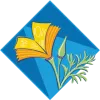The genus Salvia, a member of the mint family (Lamiaceae), offers Sonoma County gardeners one of the largest and most versatile groups of plants. With some 900 species throughout the world, 100 can be found growing in the U. S., 89 can be found growing wild in California.
Garden Ornamentals
The name Salvia is derived from the Latin word “salver” (to heal), and many species in the genus have been used for their herbal and medicinal qualities since ancient times. In the modern era, various salvias have become some of the most popular garden ornamentals.
- Salvias may be evergreen or deciduous shrubs, perennials, biennials or annuals. All have tubular blossoms, opposite leaves, and square stems that may become round with age.
- As with all plants, the Salvia species are identified by the structure of their flowers.
- All have a colorful corolla tube of fused petals with two lips of unequal length.
- The surrounding colorful calyx is also two-lipped. The upper lip may have two or three teeth or it may be undivided.
- Four slender, colored stamens and a central pistil often protrude.
- The genus offers a wide range of forms, textured foliage, and vibrantly colored blossoms that combine well with most other plants in the landscape.
- Many species attract humming birds, butterflies, and bees, but not deer and rabbits. It is the distinctive pungent odor of their leaves that acts as a repellent to garden pests.
California Natives
In California, native salvias can be found growing along the Pacific Coast, crossing inland valleys and threading their way up our rocky mountain slopes.
- These natives are adaptable to almost any garden condition, provided there is plenty of sunshine and excellent drainage. Most can be propagated by either seed or cuttings.
- Salvias have often been considered a perfect garden plant. The challenge is to choose the best species and cultivars that are at home in our summer-dry, winter-wet, Mediterranean climate.
- Nineteen species have their origins in California, and many water-wise gardeners now want to include these native plants in their landscapes.
- Most are drought tolerant once established and rebel at excessive summer irrigation.
- They are essential in restoring our wildlife habitats and offer sustainability in this era of climate change.
- The following is a list of popular species and their cultivars that are generally available in local nurseries that carry native plants.
Native Salvias for Sonoma County
Botanical Name | Common Name | Growth Habit | Height | Width | Color | Blooms | Comments |
S .apiana | White or Bee Sage | Coarsely branched | 4’ | 4 x 5’ | Lavender | Spring | Bees love foliage |
S .brandegei | Brandegee Sage | Green, bushy shrub | 4-5’ | 5-7’ | Lavender | Spring | Good cut flowers |
S .clevelandii | Cleveland Sage | Domelike shrub | 3-5’ | 5-8’ | Blue-Purple | Summer | Most popular Saliva |
S..clevelandii | ‘Winnifred Gilman’ | Compact shrub | 3-5’ | 3’ | Blue-Violet | Summer | Intense color, fragrance |
S. clevelandii | ‘Allen Chickering’ | Rounded, arching | 3-4’ | 6’ | Lavender Blue | Summer | Delightful fragrance |
S. clevelandii | ‘Whirly Blue’ | Large shrub | 4-5’ | 6’ | Rich Violet | Summer | Large flower whorls |
S .columbariae | Chia | Erect annual | 2” | 1’ | Amethyst Blue | Spring | Open sunny place |
S.leucophylla | Bee’s Bliss | Low, round shrub | 2-4’ | 6’ | Lavender Pink | Summer | Good under oaks |
S .leucophylla | ‘Figueroa’ Gray Sage | Compact hybrid | 3-4’ | 4’ | Lavender Pink | Summer | Good on dry, sunny bank |
S .leucophylla | ‘Amethyst‘ Bluff’ | Low mound shrub | 5’ | 10’ | Rosy Pink | Summer | Controls erosion |
S. mellifera | Black Sage | Round, dense shrub | 3-5’ | 3-5’ | Pale Lavender | Spring | Nectar for bees |
S. mellifera | ‘Green Carpet’ | Evergreen shrub | 2’3’ | 6’ | Medium Blue | Spring | Excellent habitat plant |
S. mellifera | ‘Terra Seca’ | Upright shrub | 2+’ | 5’ | White Lavender | Spring | Ground, wall cover |
S. sonomensis | Creeping Sage | Forms mat, creeps | 8-12” | 3-4’ | Lavender Blue | Spring | Must have good drainage |
S .sonomensis | ‘Dara’s Choice’ | Mounding sage | 18” | 3’ | Dark Purple | Spring | Likes light shade |
S. sonomensis | ‘John Farmer Bowers’ | Mat hugs ground | 6” | 3’ | Creamy White | Spring | No summer water |
S. sonomensis | ‘Mrs. Beard’ | Hybrid shrub | 2’ | 4-6’ | Pale Lavender | Spring | Edges dry beds, paths |
S .spathacea | Hummingbird Sage | Creeps, forms mats | 1-3’ | 3-4’ | Magenta | Spring | Cool sun, part shade |
S. spathacea | ‘Mix Canyon’ | Forms broad mats | 1-3’ | 3-4’ | Red | Spring | Use as understory |
S. spathacea | ‘Kawatre’ | Forms dense clump | 1-3’ | 3-4 | Magenta-Red | Spring | Fruity fragrance |
September 2023

